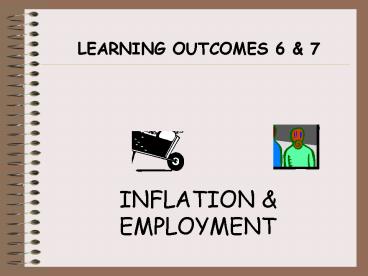LEARNING OUTCOMES 6 - PowerPoint PPT Presentation
Title:
LEARNING OUTCOMES 6
Description:
LEARNING OUTCOMES 6 & 7 INFLATION & EMPLOYMENT INFLATION This is an important performance indicator. It measures the rate of change in the general level of prices. – PowerPoint PPT presentation
Number of Views:70
Avg rating:3.0/5.0
Title: LEARNING OUTCOMES 6
1
LEARNING OUTCOMES 6 7
INFLATION EMPLOYMENT
2
INFLATION
This is an important performance indicator.
It measures the rate of change in the general
level of prices.
It indicates changes in the purchasing power of
the pound.
It is calculated using the Consumer Prices Index.
This index features the most common items
purchased by average families (basket of goods)
and monitors each month, changes in their prices.
It is calculated as follows
cost of basket of goods this month
100
_____________________________
X
CPI
cost of basket of goods in the base year
3
CALCULATION OF THE INFLATION RATE
The annual inflation rate is
X
100
this years CPI last years CPI
_________________________
last years CPI
Between any 2 years, one of which is the base
year, the rate of inflation is the difference in
the 2 index numbers.
Between any 2 years, neither of which is the base
year, the rate of inflation is the difference in
the 2 index numbers divided by the earlier index
number X 100.
The base year is given the index 100 and is used
as a reference point for comparison.
The Consumer Prices Index (CPI) is prepared
monthly by the Department of Employment.
4
WHY IS INFLATION BAD?
It reduces the power of your money to make
purchases.
It causes people on fixed incomes to experience a
fall in their real incomes.
It causes money tied up in savings to lose real
value if the rate of interest earned is not at
least equal to the rate of inflation.
It makes our exports less competitive and may
cause people to buy the comparatively cheaper
imports rather than pay rising prices.
5
WHAT CAN CAUSE INFLATION?
When the demand for goods and services outstrips
the economys capacity to produce them (ie excess
demand over supply) then demand will pull up
prices.
Excess demand over supply can arise at times of
rising general income levels.
Increases in the cost of factor inputs eg raw
materials, wages etc, when passed on to the
consumer will push up prices.
A growth in the money supply eg through excessive
lending by the financial sector will reduce the
value of the currency circulating round the
economy.
6
STRATEGIES FOR TACKLING INFLATION
Dampen down the level of demand by making
borrowing and credit more expensive.
Encourage increased capacity by encouraging
business to expand and new business to set up eg
Enterprise Allowances, Grants etc.
Ensure wage rises are accompanied by productivity
agreements.
Keep tight control of the money supply through
reduced lending, increasing reserve asset ratio
and higher interest rates.
7
UNEMPLOYMENT
represents wasted human resources
The rate of unemployment is another important
economic indicator.
It measures the number of people claiming
unemployment benefit as a percentage of the
workforce.
It is calculated as follows
Number of claimants
Unemployment Rate
__________________
X
100
Workforce
It will not necessarily give a true picture of
unemployment since not all unemployed claim
benefit and the definition of the workforce
changes from time to time.
8
CAUSES OF UNEMPLOYMENT
These fall into 2 categories
Demand factors (relate to the employer)
Supply factors (relate to the employee)
and
Demand for labour is derived from demand
for products and services they produce could
therefore be an elastic demand
Level of skills possessed
Financial incentive to work
The Business Cycle
Level of wages commanded
Structural changes
Power of the Trades Union
Substitutability
9
TYPES OF UNEMPLOYMENT
Seasonal
work which fluctuates with the time of year eg
unemployment during the winter months in the
tourist industry
Frictional
caused by delays in moving from job to job
caused by changes in the different sectors of the
economy eg shrinking manufacturing sector
Structural
Real Wage
some employers may not be prepared to afford as
many non-skilled workers who now must be paid at
least the legal minimum wage
Technological
jobs unfilled because demand for new skills is
not being matched by up-to-date training schemes
leading to a skills shortage
10
PROBLEMS CAUSED BY UNEMPLOYMENT
Individuals lose income, motivation, skills and
confidence
Firms lose output and therefore profit
Communities suffer decline and increasing crime
Governments lose tax revenues while having to
finance increased spending on benefits, training
schemes, community improvement schemes and
policing.
The Economy will contract ie falling National
Income, and cheaper imports may be sucked in
11
STRATEGIES FOR TACKLING UNEMPLOYMENT
Introduce more flexible work patterns ie job
sharing, part-time
Increase incentive to work ie bigger financial
gap between being on benefits and the minimum wage
Increase the availability of training schemes
Encourage growth in the economy eg aid to small
businesses
Regional Policy benefits to attract work to hard
hit areas of the country
Import controls to protect UK firms
Reduce employers marginal cost of employing
workers
12
UNEMPLOYMENT AND INFLATION
THE LINKS
It was generally thought that there was an
inverse relationship between inflation and
unemployment.
ie when unemployment was high, inflation was low
and when unemployment was low inflation was high
This stems from a study done by Phillips and
illustrated by his Phillips Curve.
There have however been periods of time during
which this is not the case eg mid 70s with high
inflation and unemployment and the lat 90s with
low inflation and low unemployment so Phillips
theory has broken down.

